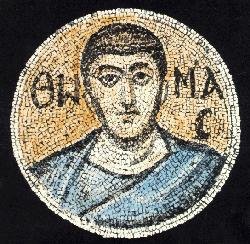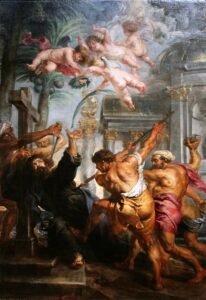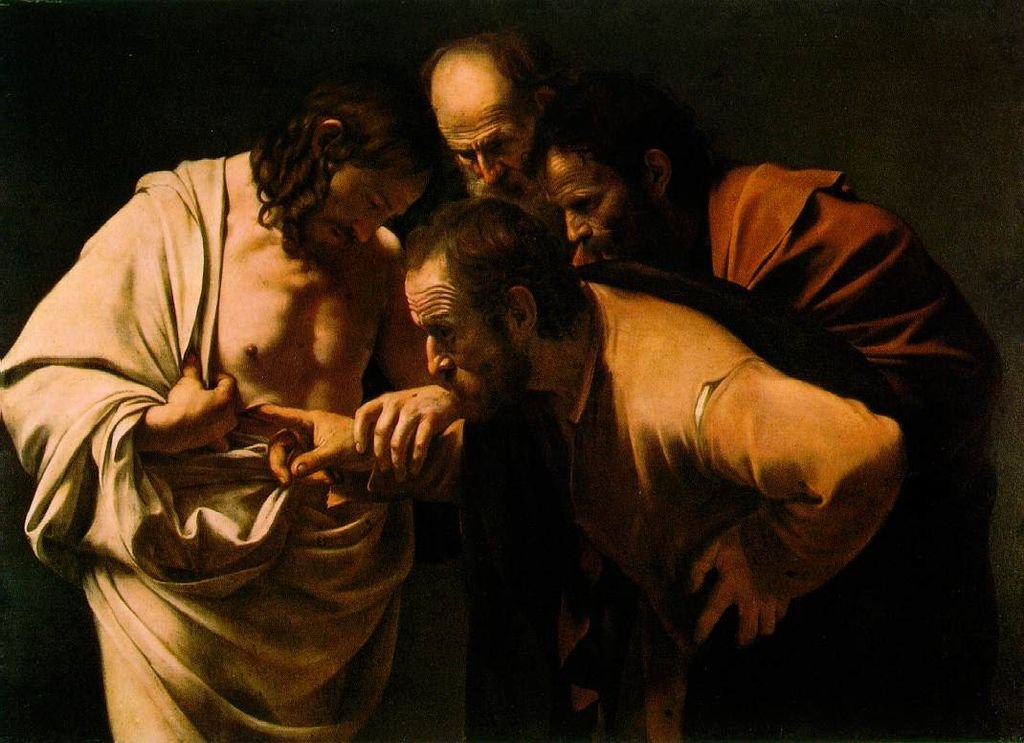St Thomas the Apostle shines brightly as a beacon of inspiration and unwavering devotion. One such luminary is St Thomas the Apostle, whose journey of faith continues to captivate hearts and minds. With every step he took alongside Jesus, St Thomas the Apostle left an indelible mark on the world, becoming a testament to the transformative power of belief. In this blog post, we invite you to embark on a soul-stirring exploration of St. Thomas the Apostle and discover the profound lessons his life offers.
Amidst the bustling streets of ancient Jerusalem, St Thomas the Apostle walked in the company of the greatest Teacher humanity has ever known. His encounters with Jesus were marked by profound curiosity, sincere questions, and, yes, even moments of doubt. It was this very doubt that earned him the enduring moniker “Doubting Thomas,” but as we delve deeper into his story, we will come to understand that his doubts were a stepping stone to an unshakeable faith.
St Thomas the Apostle was known for his thirst for truth and his unwavering desire to understand the mysteries of God’s kingdom. In his journey, he sought answers, asked probing questions, and grappled with uncertainty. But it was through his quest for truth that he encountered the resurrected Christ, witnessing firsthand the wounds inflicted on his Savior’s body. It was in that profound moment that doubt transformed into an unyielding belief, and St. Thomas uttered the words that resonate through the ages: “My Lord and my God.”
As we navigate the pages of history, we find that St Thomas the Apostle was not only a witness to the resurrection, but also an evangelist and a builder of faith. Driven by an insatiable desire to spread the good news, he ventured far and wide, carrying the light of Christ to distant lands. It is in India, a land teeming with vibrant spirituality, that St Thomas the Apostle left an indelible legacy, planting the seeds of Christianity and nurturing the faithful.
Today, St Thomas the Apostle stands as a guiding star, illuminating the path of faith for believers around the world. His story reminds us that doubt can be transformed into unwavering conviction, and that questions can lead to profound revelations. He exemplifies the beauty of seeking truth, even amidst the shadows of uncertainty. St Thomas the Apostle invites us to embark on a personal journey, where doubt can give way to a profound encounter with the risen Christ.
In the upcoming sections of this blog post, we will delve deeper into the life, teachings, and lasting impact of St Thomas the Apostle. Together, we will explore his patronage, his miracles, his martyrdom, and the sacred places associated with his name. Join us on this soul-stirring expedition as we discover the radiant light of faith that continues to shine through the life and legacy of St Thomas the Apostle.

What was St. Thomas the Apostle known for?
St Thomas the Apostle is primarily known for his doubt and subsequent declaration of faith upon encountering the resurrected Jesus. Following the crucifixion of Christ, St Thomas the Apostle struggled to accept the news of Jesus’ resurrection until he personally saw and touched the wounds on Jesus’ body.
Overwhelmed by this profound experience, he exclaimed, “My Lord and my God!” This moment has come to symbolize the power of faith, despite doubts, and is often referenced as St Thomas the Apostle’ defining act.
Beyond this iconic incident, St Thomas the Apostle was recognized for his zealous missionary work in spreading the message of Jesus Christ. Tradition holds that he traveled to various regions, including Parthia, Ethiopia, and even India, where he laid the foundation for Christianity. St. Thomas’ tireless efforts in proclaiming the Gospel to different cultures and people exemplify his unwavering commitment to his faith.
Who was Thomas before Jesus called him?
Before Jesus called him, Thomas, also known as Didymus, was a humble fisherman by trade. He was born and raised in Galilee, in the town of Bethsaida. Living in a time when the Jewish people yearned for a messiah to free them from Roman rule, Thomas had likely heard stories and prophecies about a coming Savior.
St Thomas the Apostle was known for his practical and rational nature. He had a tendency to question and seek understanding. This inquisitive mindset, combined with his loyalty and devotion, ultimately defined his journey as an apostle. While his skepticism initially led to doubt, it also played a crucial role in strengthening his faith and inspiring generations to come.
Thomas’ encounter with Jesus transformed his life. When Jesus called him to become one of the Twelve Apostles, Thomas embraced the opportunity with humility and fervor. He left behind his familiar life as a fisherman to follow Jesus and became an integral part of the inner circle of disciples.
St. Thomas the Apostle’s life and legacy continue to inspire millions around the world. His unwavering faith, even in the face of doubt, serves as a beacon of hope for those navigating their own spiritual journeys. St. Thomas’ transformation from a skeptical fisherman to a devoted disciple demonstrates the transformative power of encountering the risen Christ.
As we reflect on his life, let us strive to embody his unwavering faith and dedication, spreading the message of love, hope, and salvation to all corners of the world.
Why did Thomas touch Jesus?
Thomas’ touch of Jesus was an act born out of a genuine desire to validate the reality of Jesus’ resurrection. After Jesus appeared to the disciples following his crucifixion, Thomas, who was absent at the time, found it difficult to believe their accounts. Doubt filled his heart, and he sought tangible evidence to quell his uncertainty. It was not a gesture of skepticism alone but rather a plea for reassurance and confirmation.
When Jesus appeared to the disciples again, this time with St Thomas the Apostle present, he graciously acknowledged Thomas’ doubts. He invited Thomas to reach out and touch his wounds—the very wounds that bore the pain and suffering of the crucifixion. In that profound moment, Thomas experienced the undeniable reality of Christ’s resurrection. It was an act of divine mercy and compassion that helped transform Thomas’ doubt into unwavering faith.
What did Thomas say to Jesus?
Upon touching Jesus’ wounds, Thomas was overcome with awe and reverence. In a profound declaration of faith, he exclaimed,
“My Lord and my God!”
These simple yet profound words encapsulated St Thomas the Apostle’s realization that Jesus was not only his teacher and friend but also the embodiment of God Himself. It was a heartfelt confession, acknowledging Jesus’ divine nature and supreme authority.
St Thomas the Apostle’s declaration reverberates through the ages, reminding believers of the profound truth of Jesus’ identity. His words speak of a personal encounter that transformed doubt into a steadfast conviction. Thomas, in his profound confession, encapsulated the essence of faith—a genuine recognition of Jesus as the Lord and the Almighty.
St Thomas the Apostle’s encounter with the resurrected Jesus stands as a testament to the power of touch and the significance of heartfelt words. Through his desire to touch Jesus, St Thomas the Apostle sought confirmation, and through his declaration of faith, he embraced the divinity of Christ.
The story of St Thomas the Apostle serves as an encouragement for those who struggle with doubt, reminding us that even the most ardent disciples may experience moments of uncertainty. But by reaching out in faith and uttering sincere words of belief, we, too, can encounter the transformative presence of the risen Lord in our lives. May we, like St Thomas the Apostle, embrace the touch of faith and the power of heartfelt words as we journey on our own paths of spiritual discovery.

What did Thomas the Apostle do after Jesus died?
After Jesus’ death, Thomas, along with the other disciples, experienced a period of profound grief and confusion. However, upon witnessing the resurrection of Christ and receiving the commission to spread the Gospel, St Thomas the Apostle devoted himself wholeheartedly to the mission. He embarked on a journey to share the teachings of Jesus, traveling to different regions and communities to proclaim the Good News.
Tradition holds that Thomas ventured beyond the borders of Israel, undertaking missionary work in distant lands. It is believed that he journeyed to Parthia, present-day Iran, and ultimately reached the region of India. In India, Thomas left an indelible mark, establishing a Christian community and fervently spreading the message of Jesus. His unwavering dedication to the mission served as a beacon of hope for those seeking the path of salvation.
What miracles did the apostle Thomas perform?
Throughout his apostolic ministry, St. Thomas the Apostle is associated with several miracles that reflect the power of his faith and the grace of God working through him. These miracles have been passed down through oral tradition and ancient texts.
One of the most famous accounts is the healing of the King of India’s wife. Tradition tells us that the queen was suffering from a severe illness, and Thomas, by the power of prayer, interceded on her behalf. Miraculously, the queen was healed, and this event led to the conversion of the king and many others in the region.
Another notable miracle attributed to Thomas is the raising of the dead. It is said that Thomas encountered a young man who had tragically lost his life. Through fervent prayer, the apostle called upon the power of God, and the young man was restored to life, showcasing the extraordinary nature of Thomas’ faith.
In addition to these specific miracles, St. Thomas is revered for his ability to perform various healings, casting out demons, and bringing comfort to those in need. These acts of divine intervention bore witness to the authority and compassion bestowed upon Thomas as a chosen apostle.
St. Thomas the Apostle, after Jesus’ death, embarked on a courageous journey, carrying the torch of faith to distant lands and spreading the Gospel message. His apostolic ministry was marked by unwavering dedication, miracles, and the establishment of Christian communities. Through the power of his faith, Thomas was instrumental in transforming lives and bringing the light of Christ to those he encountered.
The miracles associated with St. Thomas remind us of the profound impact that faith can have in our lives. They serve as a testament to the divine power working through those who believe and submit to God’s will. As we reflect on the life and miracles of St. Thomas the Apostle, may we be inspired to cultivate a deep and unwavering faith, trusting in God’s providence and embracing the mission to share the Gospel with love, compassion, and unwavering conviction.
Why was Thomas the Apostle martyred?
Thomas’ martyrdom was a result of his commitment to proclaiming the teachings of Jesus, even in the face of adversity. After establishing a Christian community in India and converting many to the faith, he faced opposition from both religious and political authorities. The exact circumstances of his martyrdom may vary in different accounts, but the core story remains consistent.
Tradition holds that Thomas was condemned to death for challenging the religious practices and beliefs prevalent in the region. His unwavering commitment to Christ and refusal to renounce his faith led to his execution. It is believed that he was pierced with a spear or fatally wounded with a sword, becoming a martyr for his unyielding devotion to the Gospel.
Thomas’ martyrdom serves as a poignant reminder of the sacrifices made by early Christians to uphold their faith. His unwavering commitment to Christ’s message, even in the face of persecution, continues to inspire believers to stand firm in their convictions and embrace the transformative power of faith.

Where is St. Thomas the Apostle buried?
The final resting place of St. Thomas the Apostle holds profound spiritual significance and has become a place of pilgrimage for believers across the centuries. According to tradition, Thomas’ mortal remains were interred in Mylapore, now a neighborhood in Chennai, India.
The San Thome Basilica, a magnificent church built atop the supposed burial site, stands as a testament to Thomas’ enduring legacy. The basilica, dedicated to Our Lady of the Rosary, houses a shrine that enshrines a relic believed to be a portion of St. Thomas’ bone. Pilgrims from all walks of life visit this sacred place to pay homage to the apostle and seek his intercession.
The burial site of St. Thomas carries immense spiritual significance, not only for Christians but also for people of other faiths. It serves as a testament to the enduring power of Thomas’ witness and the universal appeal of his message of love, peace, and salvation.
St. Thomas the Apostle’s martyrdom and his final resting place stand as a testament to the enduring power of faith and the sacrifices made by early Christians. His unwavering commitment to the Gospel message, even in the face of persecution, continues to inspire believers worldwide.
As we reflect on Thomas’ martyrdom and the sacredness of his burial site, let us be reminded of the profound call to live out our faith with courage and conviction. May we draw strength from the example of St. Thomas, embracing the transformative power of our beliefs and remaining steadfast in the face of challenges. And as we contemplate the significance of the burial place of St. Thomas, may we find solace, inspiration, and a deep sense of connection to the rich tapestry of our shared spiritual heritage.
How can I make a pilgrimage to see St. Thomas the Apostle?
Making a pilgrimage to see St. Thomas the Apostle in India is an opportunity to connect with the vibrant spiritual heritage he left behind. Here are some steps to guide you on this sacred journey:
- Research and Plan: Begin by researching the pilgrimage sites associated with St. Thomas in India. The San Thome Basilica in Chennai, where his burial place is believed to be, is a significant destination. Gather information about the basilica, its history, and any specific rituals or events associated with the pilgrimage.
- Seek Guidance: Reach out to local religious organizations, travel agencies specializing in pilgrimage, or knowledgeable individuals who can provide guidance and assistance in planning your pilgrimage. They can offer valuable insights, help arrange transportation and accommodations, and provide information on any necessary permits or requirements.
- Prepare Spiritually: Before embarking on your pilgrimage, take time for personal reflection and prayer. Seek spiritual guidance, attend religious services, and engage in practices that deepen your connection to St. Thomas and your faith. Reflect on your intentions for the pilgrimage and what you hope to gain from the experience.
- Follow the Pilgrim’s Path: Once you arrive at the pilgrimage site, immerse yourself in the sacred atmosphere. Participate in religious ceremonies, venerate the relics associated with St. Thomas, and spend time in prayer and contemplation. Engage with the local community and fellow pilgrims, sharing stories and experiences.
- Reflect and Integrate: After completing your pilgrimage, take time to reflect on the insights gained, the prayers offered, and the experiences encountered. Integrate these into your daily life, allowing the pilgrimage to have a lasting impact on your spiritual journey.

What other saints are buried in India?
India is a land rich in religious and spiritual history, and alongside St Thomas the Apostle, several other saints are buried within its borders. Here are a few notable examples:
- St. Francis Xavier: The mortal remains of St. Francis Xavier, a revered Jesuit missionary, rest in the Basilica of Bom Jesus in Goa, India. Known for his tireless evangelization efforts in Asia, his burial site is a significant pilgrimage destination.
- St. Alphonsa: Canonized as India’s first woman saint, St. Alphonsa, also known as Alphonsa Muttathupadathu, is buried in Bharananganam, Kerala. Her tomb attracts countless devotees seeking her intercession and spiritual guidance.
- St. Gonsalo Garcia: St. Gonsalo Garcia, a Portuguese missionary, was martyred in Japan and his relics were later brought to India. His mortal remains now lie in the Basilica of Our Lady of the Mount in Bandra, Mumbai, where pilgrims flock to seek his intercession.
These are just a few examples among many saints buried in different parts of India. Each saint’s burial site holds its own unique spiritual significance, attracting devotees seeking solace, healing, and connection with their heavenly patrons.
Embarking on a pilgrimage to see St Thomas the Apostle in India is an extraordinary opportunity to deepen your faith and connect with the vibrant spiritual heritage he represents. By making careful travel arrangements, you can ensure a seamless and meaningful journey. In this section, we will provide you with practical guidance to help you plan your pilgrimage to see St Thomas the Apostle.
- Research and Plan Ahead: Start by researching the specific locations associated with St Thomas the Apostle in India, such as Chennai, Malayattoor, and Mylapore. Learn about the historical and cultural significance of each site and determine which ones you would like to include in your itinerary. Make a list of the must-visit places, and consider the duration of your trip to allow for a comprehensive experience.
- Obtain the Necessary Documents: Ensure that your passport is valid for at least six months beyond your planned travel dates. If required, apply for an Indian tourist visa well in advance, as the application process may take time. Check with the nearest Indian embassy or consulate for specific visa requirements and gather all the necessary documents for your application.
- Seek Guidance from Travel Experts: Consider consulting with a travel agent or tour operator specializing in religious pilgrimages. They can provide valuable insights, recommend suitable itineraries, and assist with logistical arrangements such as accommodation, transportation, and guided tours. Their expertise can simplify the planning process and ensure a more enriching experience.
- Choose the Right Time to Visit: Take into account the climate and local events when deciding on the best time to embark on your pilgrimage. India’s weather varies across regions, so research the weather patterns of your chosen destinations. Also, be mindful of any significant religious festivals or celebrations that may impact the availability of accommodations or transportation.
- Arrange Accommodations and Transportation: Book accommodations that align with your preferences and budget. Consider staying in hotels or guesthouses located near the pilgrimage sites to optimize your time and convenience. Plan your transportation options, whether it’s by air, train, or road, and make advance reservations to secure your seats or rooms.
- Pack Accordingly: Pack comfortable and modest clothing suitable for visiting religious sites. Take into account the weather conditions of the region you’re visiting and pack essentials such as sunscreen, hats, comfortable footwear, and any necessary medications. It’s also advisable to carry a copy of important documents, emergency contact numbers, and a small first-aid kit.
- Embrace the Spiritual Experience: Prepare yourself mentally and emotionally for the spiritual journey that lies ahead. Engage in personal reflection and prayer, seeking spiritual guidance and blessings. Consider attending mass or participating in religious ceremonies at the pilgrimage sites, immersing yourself in the profound faith and devotion that surround St Thomas the Apostle.
By following these steps and making careful travel arrangements, you can embark on a pilgrimage that allows you to connect with the legacy of St Thomas the Apostle and experience the spiritual richness of India. Open your heart to the transformative power of faith, and may your pilgrimage be a deeply meaningful and soul-nourishing experience.
What other Catholic things are there to see in India?
India boasts a plethora of Catholic sites that bear witness to the enduring presence of the faith. Here are a few notable destinations to consider:
- Basilica of Our Lady of the Mount, Bandra: Located in Mumbai, this beautiful basilica is dedicated to the Blessed Virgin Mary. It offers panoramic views of the Arabian Sea and serves as a place of solace and prayer for devotees seeking the intercession of the Virgin Mary.
- Basilica of Our Lady of Good Health, Velankanni: Situated in Tamil Nadu, this basilica is renowned for its miraculous healing powers. It attracts pilgrims from around the world who seek the blessings and intercession of Our Lady of Good Health.
- St. Xavier’s Cathedral, Kolkata: A magnificent cathedral in the heart of Kolkata, it is dedicated to St. Francis Xavier. The grand architecture and serene ambiance make it a must-visit for those exploring the Catholic heritage of India.
- Se Cathedral, Goa: This stunning cathedral, located in Old Goa, is one of the largest churches in Asia. Known for its impressive Portuguese-Gothic architecture, it holds religious significance as it houses the remains of St. Francis Xavier.
These are just a few examples among the many Catholic attractions scattered across India. Each site carries its unique history, spiritual significance, and architectural charm, providing an enriching experience for visitors seeking to explore the Catholic heritage of the country.
Making travel arrangements to see St. Thomas the Apostle:
When planning your pilgrimage to see St Thomas the Apostle, thoughtful travel arrangements are crucial to ensure a smooth and fulfilling experience. Here are some key considerations:
- Research and Documentation: Familiarize yourself with the necessary travel documents and visa requirements for your visit to India. Contact the appropriate authorities or consult a travel agent to ensure you have all the necessary paperwork in order.
- Transportation and Accommodation: Research the best options for transportation to your desired pilgrimage site. Whether you choose to fly, take a train, or travel by road, make sure to plan your journey in advance. Additionally, explore accommodation options near the pilgrimage site, ranging from hotels to guesthouses or religious retreat centers, ensuring a comfortable stay during your visit.
- Local Guidance: Seek guidance from local religious organizations or tour operators who specialize in pilgrimage tours. They can provide valuable insights into the best time to visit, local customs, and any specific practices associated with the pilgrimage. They may also offer assistance with logistics and arrangements, making your visit more convenient and meaningful.
- Safety and Health Considerations: Prioritize your safety and well-being by familiarizing yourself with local customs, safety guidelines, and healthcare facilities in the area. It is advisable to have travel insurance that covers medical emergencies and to consult a healthcare professional regarding any necessary vaccinations or health precautions before your trip.
- Spiritual Preparation: As you make travel arrangements, remember to nurture your spiritual preparation. Engage in prayer, reflection, and study to deepen your understanding of St Thomas the Apostle and the spiritual significance of your pilgrimage.
As you plan your journey to visit St Thomas the Apostle and explore the Catholic heritage of India, may your preparations be marked by anticipation and reverence. Beyond the sacred sites associated with St Thomas the Apostle, India offers a myriad of other Catholic attractions that are sure to enrich your spiritual journey. From ancient cathedrals to revered shrines, each destination holds its own unique history and significance. In this section, we will delve into the captivating Catholic heritage of India, showcasing the diverse array of attractions that await you.
- Basilica of Bom Jesus, Goa: Step into a world of grandeur and spirituality as you visit the Basilica of Bom Jesus in Goa. This UNESCO World Heritage Site houses the mortal remains of St. Francis Xavier, a revered saint known for his missionary work in Asia. The exquisite Baroque architecture and the serene atmosphere of the basilica create an atmosphere of profound reverence.
- St. Mary’s Cathedral, Chennai: Located in the heart of Chennai, St. Mary’s Cathedral is a magnificent testament to Gothic architecture. As one of the oldest churches in India, it holds historical and religious significance. The towering spires, intricately carved interiors, and vibrant stained glass windows transport visitors to a place of tranquility and devotion.
- Marian Shrine of Our Lady of Vailankanni, Tamil Nadu: Nestled in the town of Vailankanni, the Marian Shrine of Our Lady of Vailankanni is a place of pilgrimage for millions of devotees. Believed to have witnessed miraculous healings and appearances of the Virgin Mary, this shrine radiates faith and hope. The beautiful basilica and the serene surroundings provide a sanctuary for prayer and reflection.
- St. Thomas Syro-Malabar Catholic Church, Malayattoor: Perched atop the picturesque Malayattoor Hill in Kerala, the St. Thomas Syro-Malabar Catholic Church is a revered pilgrimage site. It is believed to be the place where St Thomas the Apostle sought solitude and engaged in intense prayer. The panoramic views, the solemn processions, and the sense of spiritual serenity make it a must-visit destination for Catholic pilgrims.
- Our Lady of the Immaculate Conception Church, Panjim: In the vibrant city of Panjim, Goa, stands the iconic Our Lady of the Immaculate Conception Church. This centuries-old church, with its striking white facade and picturesque setting, exudes a unique charm. As one of the most famous landmarks in Goa, it showcases a blend of Portuguese and Indian architectural influences, inviting visitors to experience its spiritual ambiance.
As you plan your pilgrimage to St Thomas the Apostle, consider extending your itinerary to include these remarkable Catholic attractions. Each site carries its own significance and offers a glimpse into the rich tapestry of Catholic heritage in India. Whether you seek architectural marvels, sacred relics, or moments of spiritual reflection, India’s Catholic attractions will leave an indelible impression on your journey of faith.
In the next section, we will provide practical guidance on making travel arrangements to ensure a seamless and memorable visit to St Thomas the Apostle and other Catholic sites in India.
I believe that, as it has done for me, traveling will aid in your spiritual development.
Visiting the Vatican and the Holy Land on the footsteps of the last Korean saints before they were executed for their faith. When we comprehend our purpose and what God has in store for us, that is when our lives begin to change.
I’ve been all over the place. America, Scotland, Korea, Hong Kong, Macau, The Vatican, Switzerland, France, Milan, and all of Israel are among the countries I’ve visited. Soon, I’ll be in Turkey as well.
I am well-versed in all facets of travel. As a result, I’ve put up a list of concise resources to aid you in getting ready for your voyage.
- Find cheap flights for your journey HERE
- A Car Rental
- Taxi Drivers
- Bus or Train Tickets
- Choose the Perfect Hotel for Your Trip HERE
- Fun Events for Your Journey
- Travel Insurance
- Phone for Traveling
Time to pack your bags! 🙂
What is the apostle Thomas the patron saint of?
St Thomas the Apostle, often referred to as the “Doubting Thomas,” serves as the patron saint of several areas and professions. Here are a few significant patronages associated with him:
- Architects and Builders: St Thomas the Apostle is considered the patron saint of architects and builders due to his association with constructing and establishing Christian communities. His patronage signifies the need for careful planning, steadfastness, and dedication in constructing both physical structures and spiritual edifices.
- India: As the apostle who brought Christianity to India, St Thomas the Apostle is widely regarded as the patron saint of the country. His presence and influence have left an indelible mark on the spiritual landscape of India, making him a revered figure among Indian Christians.
- Sri Lanka: St Thomas the Apostle is also considered the patron saint of Sri Lanka, where he is believed to have spent time spreading the teachings of Jesus. His legacy is celebrated in the country’s Christian traditions and culture.
- Doubters and Skeptics: Despite being known as the doubting disciple, St Thomas the Apostle’s ultimate belief and profession of faith earned him the patronage of doubters and skeptics. Those struggling with doubt or seeking assurance in their faith often turn to St Thomas the Apostle for guidance and intercession.
What do you pray to St. Thomas for?
St Thomas the Apostle is a powerful intercessor, and believers often seek his help and guidance through prayer. Here are some intentions for which individuals commonly pray to St Thomas the Apostle:
- Strengthening of Faith: Many pray to St Thomas the Apostle to deepen their faith, seeking his intercession to overcome doubts and uncertainties. They ask for the strength to believe in God’s presence and to embrace the teachings of Christ with unwavering conviction.
- Guidance in Decision-Making: St Thomas the Apostle is often invoked for guidance in making important decisions. Individuals turn to him to seek clarity, discernment, and wisdom in navigating life’s choices, relying on his example of seeking truth and understanding.
- Protection and Safe Travel: As the patron saint of travelers, St Thomas the Apostle is invoked for protection during journeys. Believers pray to him to ensure safe travels, both physically and spiritually, and to guard against unforeseen dangers.
- Intercession for India and Sri Lanka: Devotees ask for St. Thomas’ intercession to bless and protect the people and communities in India and Sri Lanka. They seek his guidance for the growth and prosperity of the Church in these regions.
- Aid for Builders and Architects: Those involved in construction projects and architectural endeavors pray to St Thomas the Apostle for guidance, inspiration, and success in their work. They ask for his intercession to bless their endeavors and help them build with integrity and excellence.
St Thomas the Apostle, as the patron saint of various aspects of life and spirituality, continues to inspire and intercede on behalf of the faithful. Whether seeking guidance, strength, protection, or inspiration, believers turn to St. Thomas, recognizing his unwavering faith and commitment to Christ. May we find solace and encouragement in his example, and may our prayers to St Thomas the Apostle bring us closer to God and deepen our spiritual journey.

Are You Inspired?
Did today’s lessons on St Thomas the Apostle inspire you in any way? The lives of the saints are interesting to read about and discuss. It has a great chance of producing spiritual fruit in our lives.
Would you like to bring up your faith and the story of St Thomas the Apostle in a brief and simple manner?
You won’t have any trouble explaining the life of St Thomas the Apostle if you’re wearing the gorgeous shirt I prepared just for you.
Wearing these t-shirts makes it fun to talk about saints with close friends, family, and complete strangers. You can now tell anyone who asks what your shirt says about St Thomas the Apostle and his heroic story that changed the world.
They could even agree to accompany you to church. Even better, you might be able to introduce them to the Gospel, which will aid in their salvation from sin. All people have sinned and fallen short of God’s glory, according to Romans 3:23. Thus, everyone requires a Savior. This should be something you can explain to them.
God sent His one and only son to live under the law in order to redeem those who were under the law. Romans 4:15–16
In order to atone for our sins, Jesus had to travel to Earth, live a sinless life and ultimately die on the cross tp make atonement for our sins so that we could be set free. According to the Bible,
“Indeed, under the law almost everything is purified with blood, and without the shedding of blood there is no forgiveness of sins.”
– Hebrews 9:22
Family, friends, and acquaintances can become members of a nearby church through the Rite of Christian Initiation for Adults (RCIA). By taking part in RCIA programs offered by their parish, students can learn everything they need to know about our magnificent Christian religion and our Compassionate Jesus.
To view the shirt design for St Thomas the Apostle, simply click the image or CLICK HERE. The BUY NOW button will lead you to the checkout page after you select your preferred size and color.
For more great saints, visit our blog HERE.

Have a few more minutes to dive into another saint?
Why not learn about:
- St. Joan of Arc – Unleash Your Inner Warrior: 21 Inspiring Facts of the Story of Her Life
- Awaken Your Soul with the Sacred Heart of Jesus: 15 Facts to Embrace His Love and Find True Peace
- 11 Facts of the Unforgettable Story of Boniface Saint: From Humble Beginnings to Heavenly Glory
- Feast Corpus Christi: Experience the Divine -14 Facts on this Most Holy Celebration
Have you considered about coming back every day to read more about the Saint of the Day after being motivated by learning about St Thomas the Apostle? If you’d like to receive my daily saint emails in your inbox, kindly take a moment to join up. I’ll make it brief since I know you have a lot on your plate, but I’ll say more because I want you to gain wisdom from me and grow as a saint every day.
In addition, I’ll give you a free screensaver for your phone. As soon as you submit the form, I’ll email you a link to download the screensaver. Enjoy!
Thanks so much for taking the time to learn and read about my post on St Thomas the Apostle. I’ll pray that you’ll experience God’s will for your life after you grow closer to St Thomas the Apostle.
Well, that’s all for today.
I’ll see you back tomorrow with another Saint of the Day to inspire you!
God bless you,
-Priscilla




